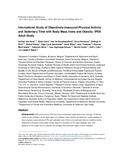Mostrar el registro sencillo del ítem
International study of objectively-measured physical activity and sedentary time with body mass index and obesity: IPEN adult study
| dc.creator | Dyck, Delfien Van | es_ES |
| dc.creator | Cerin, Ester | es_ES |
| dc.creator | Bourdeaudhuij, Ilse de | es_ES |
| dc.creator | Hinckson, Erica A. | es_ES |
| dc.creator | Reis, Rodrigo S. | es_ES |
| dc.creator | Davey, Rachel | es_ES |
| dc.creator | Sarmiento, Olga L. | es_ES |
| dc.creator | Mitas, Josef | es_ES |
| dc.creator | Troelsen, Jens | es_ES |
| dc.creator | Aguinaga Ontoso, Inés | es_ES |
| dc.date.accessioned | 2019-04-03T07:22:25Z | |
| dc.date.available | 2019-04-03T07:22:25Z | |
| dc.date.issued | 2015 | |
| dc.identifier.issn | 0307-0565 (Print) | |
| dc.identifier.issn | 1476-5497 (Electronic) | |
| dc.identifier.uri | https://hdl.handle.net/2454/32797 | |
| dc.description.abstract | BACKGROUND: Physical activity (PA) has been consistently implicated in the etiology of obesity, whereas recent evidence on the importance of sedentary time remains inconsistent. Understanding of dose-response associations of PA and sedentary time with overweight and obesity in adults can be improved with large-scale studies using objective measures of PA and sedentary time. The purpose of this study was to examine the strength, direction and shape of dose-response associations of accelerometer-based PA and sedentary time with body mass index (BMI) and weight status in 10 countries, and the moderating effects of study site and gender. METHODS: Data from the International Physical activity and the Environment Network (IPEN) Adult study were used. IPEN Adult is an observational multi-country cross-sectional study, and 12 sites in 10 countries are included. Participants wore an accelerometer for seven consecutive days, completed a socio-demographic questionnaire and reported height and weight. In total, 5712 adults (18-65 years) were included in the analyses. Generalized additive mixed models, conducted in R, were used to estimate the strength and shape of the associations. RESULTS: A curvilinear relationship of accelerometer-based moderate-to-vigorous PA and total counts per minute with BMI and the probability of being overweight/obese was identified. The associations were negative, but weakened at higher levels of moderate-to-vigorous PA (>50 min per day) and higher counts per minute. No associations between sedentary time and weight outcomes were found. Complex site- and gender-specific findings were revealed for BMI, but not for weight status. CONCLUSIONS: On the basis of these results, the current Institute of Medicine recommendation of 60 min per day of moderate-to-vigorous PA to prevent weight gain in normal-weight adults was supported. No relationship between sedentary time and the weight outcomes was present, calling for further examination. If moderator findings are confirmed, the relationship between PA and BMI may be country- and gender-dependent, which could have important implications for country-specific health guidelines. | en |
| dc.description.sponsorship | This study was supported by IPEN, International Physical Activity and the Environment Network, with funding from NIH Grant R01 CA127296. | en |
| dc.format.extent | 21 p. | |
| dc.format.mimetype | application/pdf | en |
| dc.language.iso | eng | en |
| dc.publisher | Springer Nature | en |
| dc.relation.ispartof | International Journal of Obesity volume 39, pages 199–207 (2015) | en |
| dc.rights | © 2014, Springer Nature | en |
| dc.subject | Physical activity | en |
| dc.subject | Wight status | en |
| dc.subject | Sedentary time | en |
| dc.subject | Physical activity and the Environmental Network (IPEN) | en |
| dc.subject | Body mass index | en |
| dc.title | International study of objectively-measured physical activity and sedentary time with body mass index and obesity: IPEN adult study | en |
| dc.type | info:eu-repo/semantics/article | en |
| dc.type | Artículo / Artikulua | es |
| dc.contributor.department | Ciencias de la Salud | es_ES |
| dc.contributor.department | Osasun Zientziak | eu |
| dc.rights.accessRights | info:eu-repo/semantics/openAccess | en |
| dc.rights.accessRights | Acceso abierto / Sarbide irekia | es |
| dc.identifier.doi | 10.1038/ijo.2014.115 | |
| dc.relation.publisherversion | https://doi.org/10.1038/ijo.2014.115 | |
| dc.type.version | info:eu-repo/semantics/acceptedVersion | en |
| dc.type.version | Versión aceptada / Onetsi den bertsioa | es |


